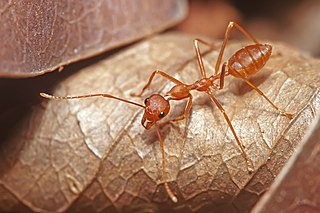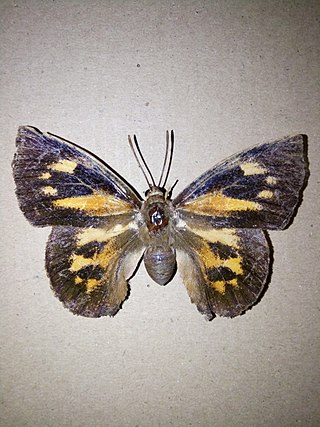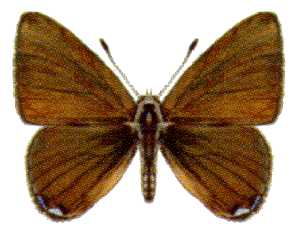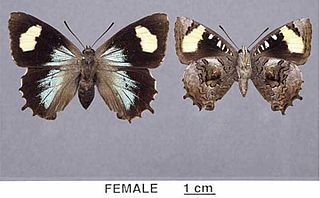
Caterpillars are the larval stage of members of the order Lepidoptera.

Lepidoptera or lepidopterans is an order of winged insects that includes butterflies and moths. About 180,000 species of the Lepidoptera have been described, representing 10% of the total described species of living organisms, making it the second largest insect order with 126 families and 46 superfamilies. and one of the most widespread and widely recognizable insect orders in the world.

Fire ants are several species of ants in the genus Solenopsis, which includes over 200 species. Solenopsis are stinging ants, and most of their common names reflect this, for example, ginger ants and tropical fire ants. Many of the names shared by this genus are often used interchangeably to refer to other species of ant, such as the term red ant, mostly because of their similar coloration despite not being in the genus Solenopsis. Both Myrmica rubra and Pogonomyrmex barbatus are common examples of non-Solenopsis ants being termed red ants.

The large blue is a species of butterfly in the family Lycaenidae. The species was first defined in 1758 and first recorded in Britain in 1795. In 1979 the species became mostly extinct in Britain but has been successfully reintroduced with new conservation methods. The species is classified as "near threatened" on the IUCN Red List of Threatened Species. Today P. arion can be found in Europe, the Caucasus, Armenia, western Siberia, Altai, north-western Kazakhstan and Sichuan.

The common blue butterfly or European common blue is a butterfly in the family Lycaenidae and subfamily Polyommatinae. The butterfly is found throughout the Palearctic and has been introduced to North America. Butterflies in the Polyommatinae are collectively called blues, from the coloring of the wings. Common blue males usually have wings that are blue above with a black-brown border and a white fringe. The females are usually brown above with a blue dusting and orange spots.

Lycaenidae is the second-largest family of butterflies, with over 6,000 species worldwide, whose members are also called gossamer-winged butterflies. They constitute about 30% of the known butterfly species.

Oecophylla smaragdina is a species of arboreal ant found in tropical Asia and Australia. These ants form colonies with multiple nests in trees, each nest being made of leaves stitched together using the silk produced by the ant larvae: hence the name 'oecophylla' [Greek for 'leaf-house'].

Liphyra brassolis, also known as the moth butterfly, is a butterfly found in South Asia, Southeast Asia and Australia that belongs to the lycaenid family. The larvae are predatory and feed on ant larvae. This is one of the largest species of lycaenid butterflies. Several disjunct populations across its wide distribution range are considered as subspecies. Never a common butterfly, specimens of this species are highly prized by collectors.

Myrmecophily is the term applied to positive interspecies associations between ants and a variety of other organisms, such as plants, other arthropods, and fungi. Myrmecophily refers to mutualistic associations with ants, though in its more general use, the term may also refer to commensal or even parasitic interactions.

Liphyra is a butterfly genus in the family Lycaenidae. It was first described by John O. Westwood in 1864. The larvae are predatory and feed on ant larvae. They are among the largest species of lycaenid butterflies. There are several species in the genus which are found in Asia and Australia. In the genus Liphyra, the antenna tapers gradually.

Illidge's ant-blue butterfly, is an endangered species of butterfly endemic to Australia. This species can be found at six confirmed sites: Mary River Heads, Beaver Rock and Maaroom in the Fraser Coast Region (Queensland); Redland Bay and Point Halloran in the City of Redland (Queensland), and Brunswick Heads.

Phengaris rebeli, common name mountain Alcon blue, is a species of butterfly in the family Lycaenidae. It was first found and described in Styria, Austria, on Mount Hochschwab around 1700. Although it was initially classified as a subspecies of P. alcon, a European researcher, Lucien A. Berger, designated it as a separate species in 1946. Genetic similarities between P. rebeli and P. alcon have led many researchers to argue that the two are the same species and differences are due to intraspecific variation.

Zizina labradus, the common grass blue, grass blue, or clover blue, is a small Australian butterfly of the family Lycaenidae.

Jalmenus evagoras, the imperial hairstreak, imperial blue, or common imperial blue, is a small, metallic blue butterfly of the family Lycaenidae. It is commonly found in eastern coastal regions of Australia. This species is notable for its unique mutualism with ants of the genus Iridomyrmex. The ants provide protection for juveniles and cues for adult mating behavior. They are compensated with food secreted from J. evagoras larvae. The ants greatly enhance the survival and reproductive success of the butterflies. J. evagoras lives and feeds on Acacia plants, so butterfly populations are localized to areas with preferred species of both host plants and ants.

Acrodipsas brisbanensis, the bronze ant-blue or large ant-blue, is a butterfly of the family Lycaenidae. It is found in Australia.

Acrodipsas cuprea, the copper ant-blue or cuprea ant-blue, is a butterfly of the family Lycaenidae. It is found in Australia, from southern Queensland to Victoria.
Jalmenus pseudictinus, Macqueen's hairstreak, is a butterfly of the family Lycaenidae. It is endemic to the northern Gulf, the north-east coast and the Murray–Darling basin in Queensland, Australia.
Jalmenus aridus, the inland hairstreak or desert blue, is a butterfly of the family Lycaenidae. It is only known from the area near Kalgoorlie in Western Australia, and is considered to be endangered species

Ogyris genoveva, the genoveva azure or southern purple azure, is a butterfly of the family Lycaenidae. It is found in Australia.

The fiery copper or dull copper is an endemic Australian butterfly of the family Lycaenidae. One of the two subspecies, P. p. lucida, is commonly known as the Eltham copper.

















